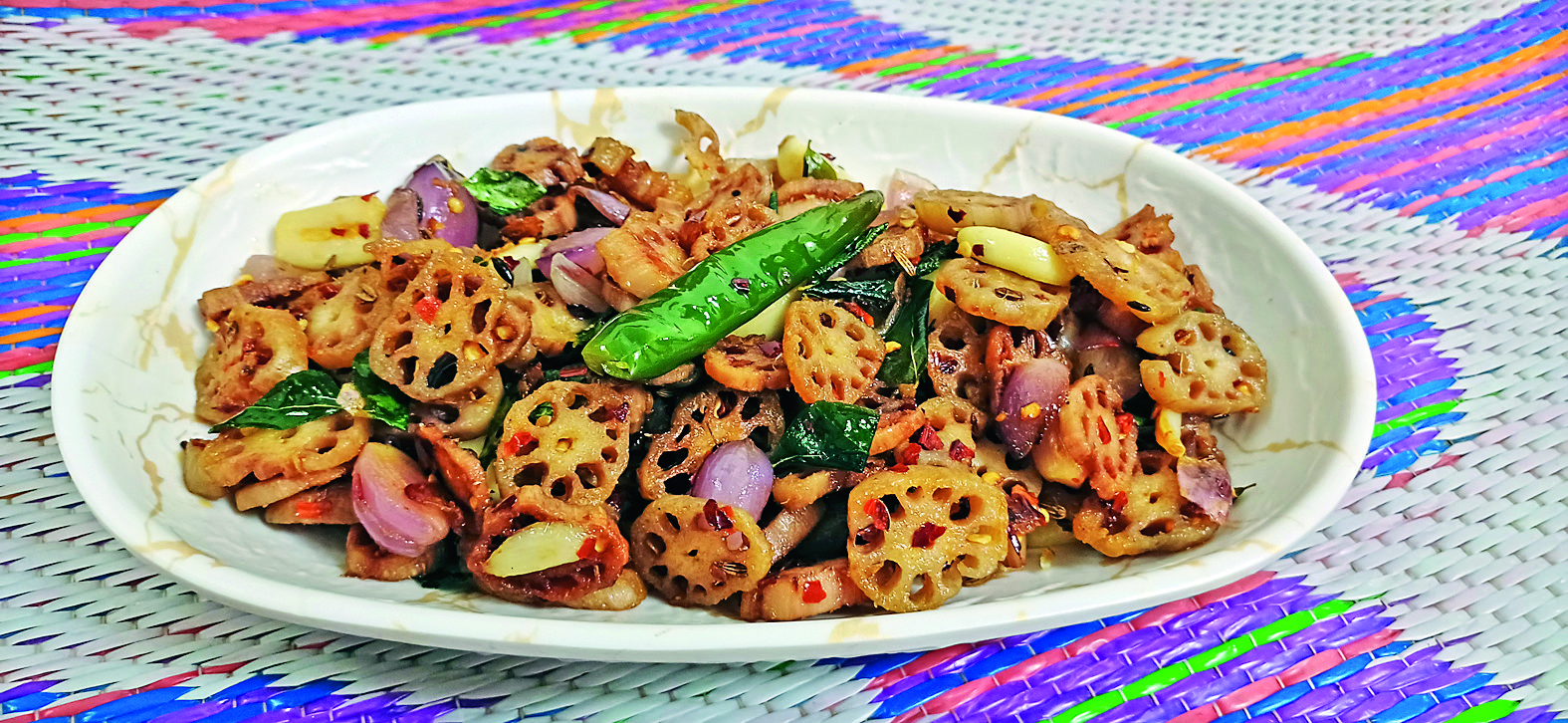
Lotus stems have been used in Indian cuisine for years and are now gaining popularity. Besides traditional recipes being revived fusion dishes of lotus stem add a delicious flavour to restaurant and cafe menus. Lotus stems chaat, honey chilli lotus stem as a starter, chips Kebabs, crispy tikkis, and much more!
All parts of the lotus plant can be used: The young flower stalks, the stem or root and the seeds (popularly known as Makhana). The lotus stem is the long, tubular stem connecting the lotus flower to its roots. It is commonly known as Kamal Kakdi, Nadur, Kamal Thamarai, and Tamara and has been cooked in various parts of India for ages. Lotus Stem adds a distinctive touch to culinary creations. The crispiness of the stem adds a delectable crunch to the dishes. The hollow tubes of the lotus stem, look attractive when sliced due to the holes in them. They can be combined to cook with various vegetables, dals, leafy greens, curd and even fish and mutton.
Health benefits
The fibre-rich Lotus stem has many health benefits, says Dhriti Udeshi. The Mumbai-based fat loss and weight management expert, nutritionist and founder at ‘Newtrition,’ shares, “Lotus stem is high in dietary fibre so it’s a great option for diabetics or anyone looking to manage their weight. High fibre foods have a high satiety value and are good for digestion. They have a low glycaemic index and is rich in vitamin C which helps boost immunity. This low-calorie root (100g stem contains approx. 70 kcal) is a good source of potassium which helps lower blood pressure levels.”
Lotus stems in modern cuisines.
The lotus stem’s resurgence in India highlights its nutritional benefits. “Its presence in restaurant menus reflects an appreciation for its health benefits and versatility in both traditional and modern dishes. Lotus stem, with its crispness and subtle flavour, is often served as a starter, and as a vegetable, either in curry or dry form, in both traditional and fusion styles. Lotus stem’s crisp texture and subtle flavour make it perfect as a starter or in curries and dry dishes. It shines in traditional recipes and modern fusion styles, offering diverse culinary possibilities. Used in Indian, Chinese and Japanese cuisines, the lotus stem’s versatility is celebrated worldwide. It appears in Kashmiri fritters, Chinese stir-fries, and Japanese simmered dishes, showcasing its global appeal and adaptability,” states Chef Prem Kumar Pogakula, Cluster Executive Chef of the Westin Hyderabad (Mindspace and The Westin Hi-Tech)
In Indian cuisine, lotus root is commonly used in both vegetarian and non-vegetarian dishes, says Vidyalakshmi, food blogger from Chennai who also runs her cooking channel on YouTube. “We enjoyed the thamarai thandu kootu with kara kuzhambu prepared by Amma during the monsoon. Revered as a sacred flower Lotus wicks were prepared from the fibre of Lotus stem at home after peeling it. People light lamps using these fibrous wicks to worship Goddess Mahalakshmi on Fridays. Lotus root is similar to a potato in texture and taste and can be used in many ways. Today the new generation is also curious to try it as they enjoy the fusion dishes made of Lotus stems,” she adds.
Lotus Stem and Omelette Steamed Bun Recipe
l 250 grams of lotus stem, peeled and sliced thin
l 1 tablespoon soy sauce
l 1 tablespoon sesame oil
l 2 eggs
l 1 teaspoon sesame seeds
l 1 teaspoon finely chopped ginger
l 1 teaspoon finely chopped garlic
l 1 green chilli, chopped
l 4 steamed buns
l Fresh coriander and chopped spring onion for garnish
Method
l Boil lotus stem slices in salted water until tender. Drain and sauté with soy sauce, sesame oil, ginger, garlic, and green chilli until crispy.
l Make Omelette
l Beat eggs with soy sauce. Cook in a non-stick pan to make a thin Omelette. Cool slightly, then cut into julienne strips.
l Open each steamed bun. Fill with lotus stem and julienne Omelette. Sprinkle with sesame seeds and garnish with fresh coriander and spring onion.
Vidyalakshmi
Ingredients:
l 300 Grams Lotus stem
l 10 Garlic Pearls
l 10 Small Shallots (Sambar Onion)
l Few Curry leaves
l 2 Green Chilies
l 1/2 Tea Spoon Fennel Seeds
l 1/2 Tea Spoon Ginger and Garlic Paste
l 1 Tea Spoon Chilli Flakes
l 1/4 Tea Spoon Asafoetida
l 2 Table Spoon Coconut Oil
l Vegetable Oil for Frying
l 1/2 Tea Spoon Salt
Prep:
l Peel the lotus stem and slice it into thin coins. And rinse it thoroughly.
l Boil 3 cups of water with 1/2 tsp Salt. Add the chopped lotus stem to boiling water. Stir occasionally and allow the Lotus stem to cook for 5 minutes. Strain the cooked lotus stem.
l Peel the shallots. Cut into half. Peel and chop the garlic.
Method:
Heat vegetable oil in a wok and fry small batches of lotus stems till light golden brown. Keep aside.
Heat a pan on medium flame. Add 2 Tbsp coconut oil. Add fennel seeds, garlic shallots, curry leaves and slit green chillies, fry all the ingredients on high flame. Add asafoetida, ginger and garlic paste and stir Add the fried lotus stem a chilli flakes stir and fry for 2 minutes on medium flame.
“Lotus stem is high in dietary fibre. it’s a great option for diabetics or anyone looking to manage their weight. it has a high safety value and is good for digestion. — Dhriti Udeshi, fat loss and weight management expert, nutritionist and founder of Newtrition.
